
Sphaeralcea is a genus of flowering plants in the mallow family (Malvaceae). There are about 40-60 species, including annuals, perennials, and shrubs. Most originate in the drier regions of North America, with some known from South America. They are commonly known as globemallows, globe mallows, false mallows or falsemallows. The name of the genus is derived from the Greek words σφαῖρα (sphaira), meaning "sphere," and αλκεα (alkea), meaning "mallow."

Penstemon palmeri, known by the common name Palmer's penstemon, is a species of perennial flowering plant in the genus Penstemon that is notable for its showy, rounded flowers, and for being one of the few scented penstemons. The plant, in the family Plantaginaceae, is named after the botanist Edward Palmer.
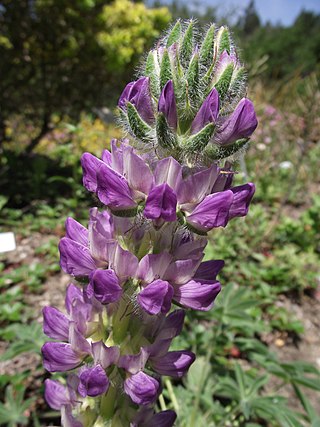
Lupinus microcarpus, the wide-bannered lupine or chick lupine, is a species of lupine native to western North America from southwestern British Columbia south through Oregon and California, including the Mojave Desert, and into Baja California. There is also a disjunct population in South America, with locations in central Chile and western Argentina.

Frangula californica is a species of flowering plant in the buckthorn family native to western North America. It produces edible fruits and seeds. It is commonly known as California coffeeberry and California buckthorn.
Sphaeralcea incana, with the common names gray globemallow and soft globemallow, is a desert plant in the mallow family (Malvaceae).
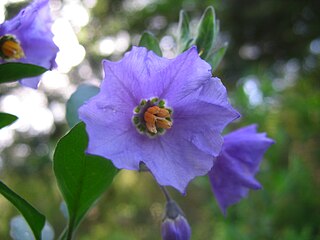
Solanum xanti, known commonly as chaparral nightshade, purple nightshade, and San Diego nightshade, is a member of the genus Solanum. It is native to the Western United States in Arizona, California, Nevada, and Oregon, and to northwest Mexico in Baja California.

Nassella pulchra, basionym Stipa pulchra, is a species of grass known by the common names purple needlegrass and purple tussockgrass. It is native to the U.S. state of California, where it occurs throughout the coastal hills, valleys, and mountain ranges, as well as the Sacramento Valley and parts of the Sierra Nevada foothills, and Baja California.

Rubus ursinus is a North American species of blackberry or dewberry, known by the common names California blackberry, California dewberry, Douglas berry, Pacific blackberry, Pacific dewberry and trailing blackberry.
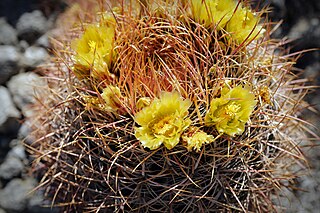
Ferocactus cylindraceus is a species of barrel cactus which is known by several common names, including California barrel cactus, Desert barrel cactus, compass barrel cactus, and miner's compass. It was first described by George Engelmann in 1853.

Sambucus racemosa is a species of elderberry known by the common names red elderberry and red-berried elder.

Mentzelia multiflora, commonly known as Adonis blazingstar, Adonis stickleaf, desert blazingstar, prairie stickleaf and manyflowered mentzelia is a herbaceous perennial wildflower of the family Loasaceae.

Celtis reticulata, with common names including netleaf hackberry, western hackberry, Douglas hackberry, netleaf sugar hackberry, palo blanco, and acibuche, is a small- to medium-sized deciduous tree native to western North America.

Sidalcea malviflora is a species of flowering plant in the mallow family, known by the common names dwarf checkerbloom, Greek mallow, prairie mallow and dwarf checkermallow.

Sidalcea oregana is a species of flowering plant in the mallow family known by the common name Oregon checkerbloom.
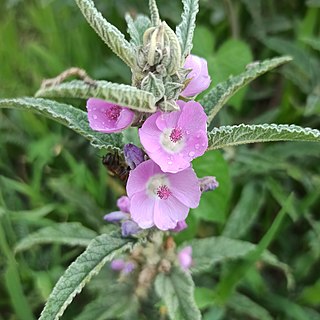
Sphaeralcea angustifolia is a species of flowering plant in the mallow family known by the common names copper globemallow and narrow-leaved globemallow. It is native to the southwestern United States as well as northern and central Mexico, where it grows in desert and plateau habitat. It produces many erect stems, approaching three meters in maximum height. It is woolly or felt-like in texture. The gray-green leaf blades are lance-shaped and measure up to about 5 cm long. They have wavy or slightly lobed edges. The leafy inflorescence bears several flowers each with five wedge-shaped orange petals just under 1 cm in length, and yellow anthers.

Sphaeralcea coulteri is a species of flowering plant in the mallow family known by the common name Coulter's globemallow. It is native to the Sonoran Desert, its distribution extending from northern Mexico north into California and Arizona. It is an annual herb, its slender, hairy stems sprawling or growing erect to a maximum height near 1.5 meters. The thin, gray-green leaf blades are wide and short, heart-shaped or triangular in shape, and measure up to about 5 centimeters long. They have a few wide lobes along the edges which may have teeth or smaller lobes. The leafy inflorescence bears clusters of flowers each with five wedge-shaped orange petals around a centimeter long, and yellow anthers.

Sphaeralcea emoryi is a species of flowering plant in the mallow family known by the common name Emory's globemallow. It is native to the Southwestern United States, California and Northwestern Mexico. It grows in desert habitat and sometimes disturbed areas such as roadsides.

Sphaeralcea grossulariifolia is a species of flowering plant in the mallow family known by the common name gooseberryleaf globemallow. It is native to the western United States, where it can be found in the Great Basin and surrounding regions. It grows in sagebrush, woodlands, playas, and the canyons of the upper Colorado River. It is common in disturbed areas, such as habitat recently cleared by wildfire.

Sphaeralcea munroana is a species of flowering plant in the mallow family known by the common names Munro's globemallow and Munro's desert-mallow. It is native to the western United States, where it can be found in the Great Basin and surrounding regions. It grows in sagebrush, desert flats, mountain slopes, and requires plenty of sunlight to thrive. This perennial herb produces erect stems up to about 80 centimetres (31 in) tall from a thick root system. It is woolly and gray-green in color. The alternately arranged leaves have triangular blades up to 6 cm long, usually edged with large lobes and a toothed margin. Flowers occur in clusters on a raceme-like inflorescence. The flower has five apricot to red-orange petals each just over 1 cm long.
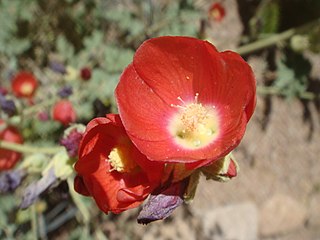
Sphaeralcea rusbyi is a species of flowering plant in the mallow family known by the common names Rusby's globemallow and Rusby's desert-mallow. It is native to the southwestern United States, where it can be found in various types of desert habitat. The species is generally divided into three subtaxa which grow in separate sections of the desert southwest. In general, the plant produces hairy or woolly stems which can reach three meters tall. The leaves are lobed or compound. The flowers each have five red-orange petals up to 2 centimeters long.




















